
Piedras natales de octubre: Explorando el ópalo y la turmalina
Los nacidos en octubre tienen dos piedras de nacimiento tradicionales: la turmalina y el ópalo. Ambas gemas únicas poseen una hermosa y diversa gama de colores y efectos ópticos.
Al igual que septiembre, el mes de octubre recibió su nombre del latín octo , que significa "ocho", por su lugar original en el calendario romano primitivo de 10 meses. Los anglosajones llamaban a octubre Winterfylleth , que significa "luna llena de invierno", porque creían que el invierno comenzaba durante la luna llena de octubre.
Una interesante festividad romana de octubre era Mundus Patet , donde los reinos de los vivos y los muertos estaban abiertos el uno al otro.
Hoy en día, festividades similares como el Día de Muertos y Halloween se celebran en octubre. Octubre simboliza la plenitud, la cosecha de lo sembrado y el ciclo de la vida.
¡Veamos si ese simbolismo coincide con las piedras natales de octubre! Hoy repasaremos la historia, las propiedades, los significados y los usos de la turmalina y el ópalo como piedras natales de octubre.
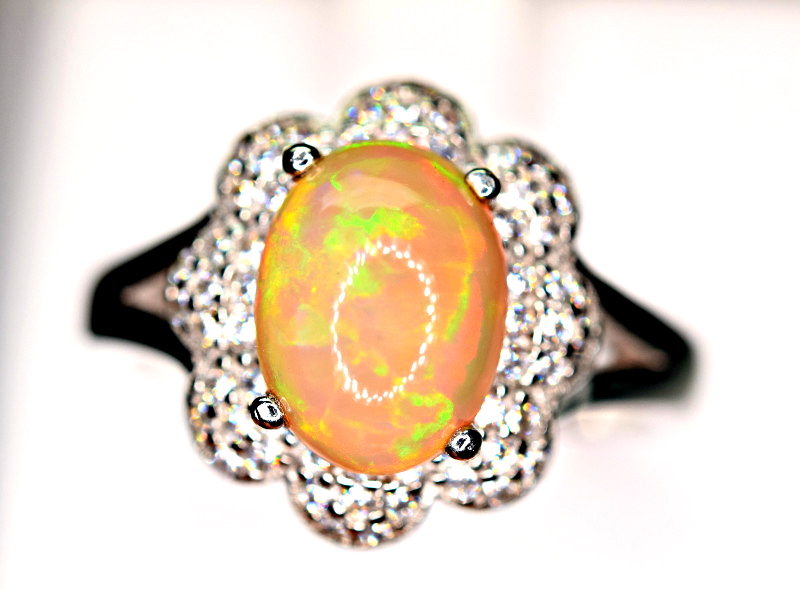 En la imagen de arriba: Anillo de ópalo precioso
En la imagen de arriba: Anillo de ópalo precioso
Importancia histórica y cultural de las piedras natales de octubre
¿Cuál es la piedra de nacimiento oficial de octubre? Hay dos piedras semipreciosas designadas oficialmente como piedras de nacimiento de octubre: el ópalo y la turmalina .
Pero ¿por qué hay dos piedras de nacimiento para octubre? Bueno, no siempre hubo dos.
Las primeras listas de piedras de nacimiento, creadas entre los siglos I y V d. C. e inspiradas en las listas de piedras preciosas bíblicas, tenían como piedra de nacimiento de octubre el berilo (o aguamarina específicamente).
Las listas formalizadas modernas comenzaron en 1870, cuando Tiffany & Co publicó un folleto de “Poemas sobre piedras de nacimiento gregorianas”. El poema de octubre era sobre el ópalo.
La primera lista estandarizada provino de la Asociación Nacional de Joyeros (ahora Joyeros de América) en 1912, quienes designaron al ópalo como la piedra de nacimiento principal de octubre y a la turmalina como la alternativa.
En la década de 1950, el Consejo de la Industria Joyera de Estados Unidos modificó la lista de 1912 y nombró específicamente a la turmalina rosa como la alternativa de octubre.
La lista estadounidense más reciente de 2016 otorga al ópalo y a la turmalina rosa la misma prioridad para octubre. La lista británica de 2013 solo incluye el ópalo.
Sorprendentemente, las dos joyas que honran el “oscuro y espeluznante” mes de octubre tienen su raíz en gran medida en la tradición relacionada con el arcoíris.
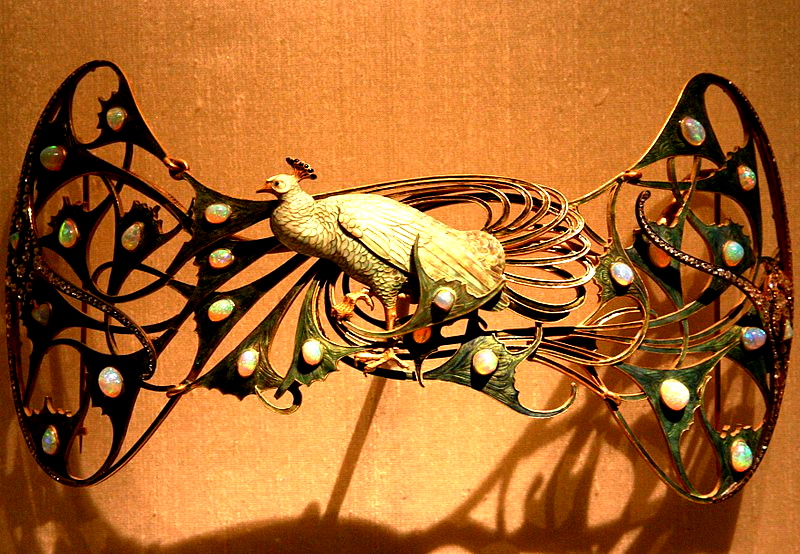 En la foto de arriba: René Lalique (1860-1945); Adorno de ramillete 'Pavo real', alrededor de 1898-1900 con oro, ópalos, diamantes y esmalte; Museo Calouste Gulbenkian | Crédito de la imagen: © José Luiz Bernardes Ribeiro / CC BY-SA 3.0
En la foto de arriba: René Lalique (1860-1945); Adorno de ramillete 'Pavo real', alrededor de 1898-1900 con oro, ópalos, diamantes y esmalte; Museo Calouste Gulbenkian | Crédito de la imagen: © José Luiz Bernardes Ribeiro / CC BY-SA 3.0
Orígenes míticos del ópalo y folclore antiguo
Los antiguos griegos creían que los ópalos se formaban a partir de lágrimas de alegría derramadas por el dios del cielo Zeus después de derrotar a los Titanes.
Los antiguos romanos consideraban el ópalo la reina de las gemas. El erudito romano Plinio el Viejo escribió que los ópalos poseían las mejores cualidades de otras piedras preciosas como el rubí , la esmeralda y la amatista .
La tradición indígena australiana (a veces llamada “aborigen”) sobre el ópalo se remonta a siglos atrás.
Un mito sobre los orígenes del ópalo es el de la Serpiente Arcoíris , un ser poderoso que volaba entre pozos de agua y sus escamas iridiscentes caían a la tierra como ópalos.
Otro mito australiano sobre el origen del ópalo dice que un espíritu creador ancestral llegó a la Tierra viajando en un arcoíris y los ópalos surgieron donde sus pies tocaron el suelo.
Un antiguo mito indio dice que la Diosa Madre convirtió a la Diosa Virgen del Arcoíris en un ópalo para ayudarla a escapar de los afectos no deseados de múltiples dioses que la perseguían.
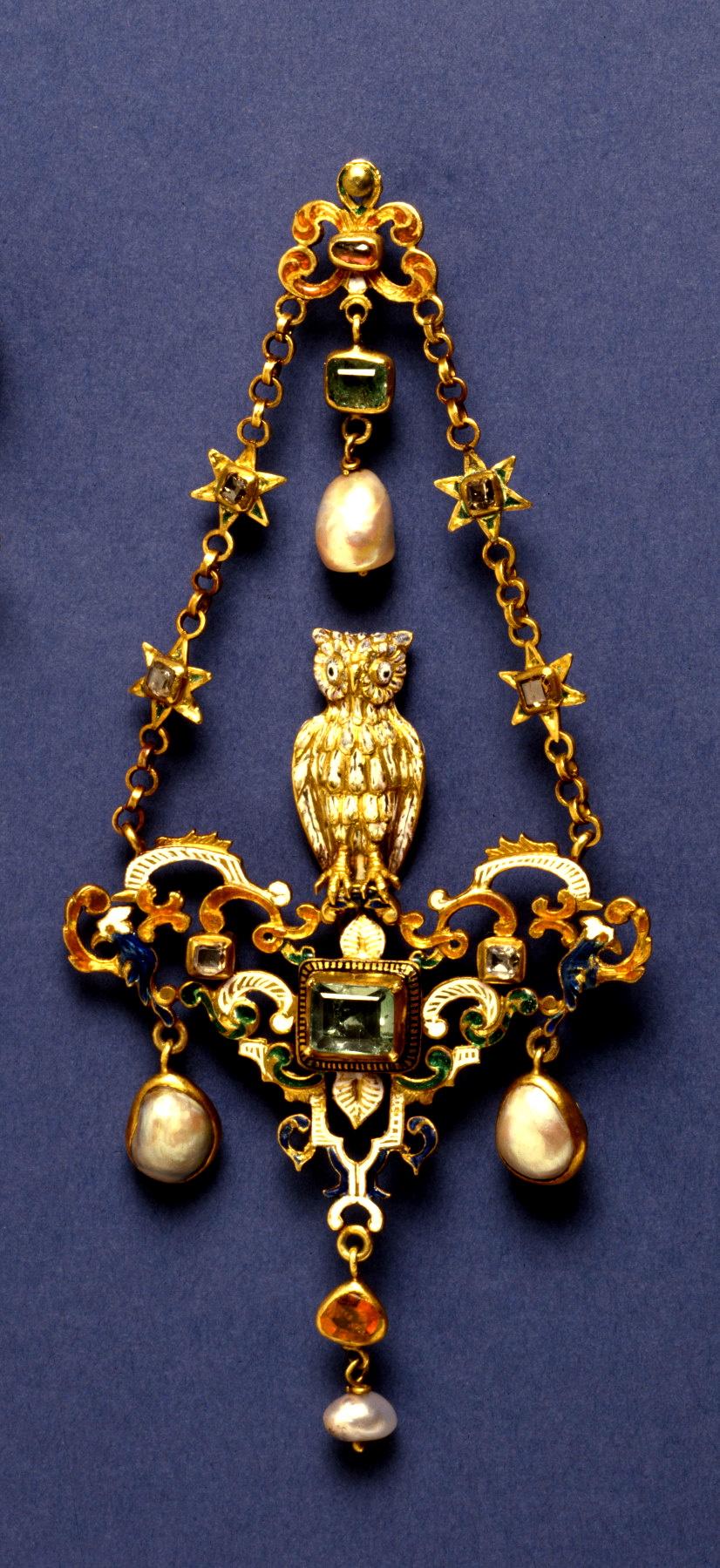 En la imagen superior: Colgante de búho dorado con turmalina, rubí, diamante y perla. Data del siglo XIX, aunque antes se creía que era del siglo XVI. Exhibido en el Museo de Arte Walters. Crédito de la imagen: Museo de Arte Walters, dominio público.
En la imagen superior: Colgante de búho dorado con turmalina, rubí, diamante y perla. Data del siglo XIX, aunque antes se creía que era del siglo XVI. Exhibido en el Museo de Arte Walters. Crédito de la imagen: Museo de Arte Walters, dominio público.
Las diversas conexiones históricas de la turmalina
La turmalina tiene una historia un poco más corta que la del ópalo, pero es igualmente fascinante.
El nombre de esta piedra natal de octubre proviene de la palabra cingalesa (de Sri Lanka) turmali, que significa "gemas mixtas". Los comerciantes holandeses acuñaron el nombre para las piedras de colores presentes en los paquetes de gemas de Sri Lanka.
El comercio holandés de “schorl” (turmalina negra) se remonta al menos al siglo XV, si no antes.
Otro descubrimiento histórico de turmalina se produjo en 1554. El conquistador español Francisco Spinoza encontró una turmalina verde en Brasil que denominó “esmeralda brasileña”.
Otro error notable en la identificación de la turmalina es el « rubí de César », una piedra roja con una historia entre la realeza francesa y rusa que se remonta al siglo XVI. Se descubrió que era una turmalina rubelita en la década de 1920.
De hecho, los comerciantes probablemente llamaban a las turmalinas coloreadas otras piedras preciosas hasta que se analizó la primera especie (el chorlo) en 1785. La especie no fue plenamente reconocida hasta después del descubrimiento del boro en 1808.
Después de que se descubriera la turmalina en California en 1892, gran parte de la turmalina rosa del estado se vendió a la emperatriz viuda china Tz'u Hsi, quien favorecía la gema.
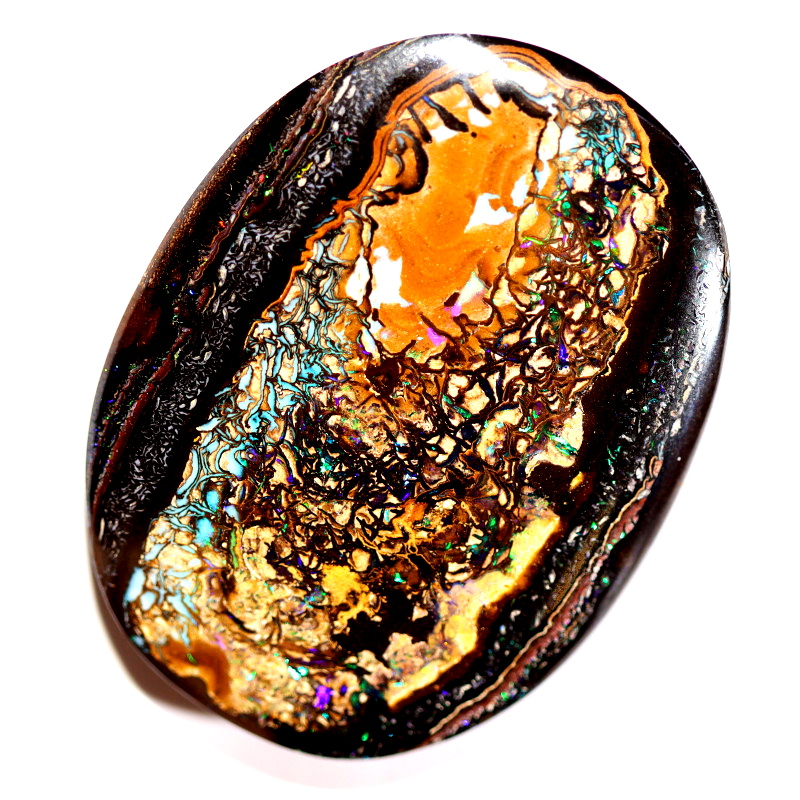 En la imagen de arriba: Ópalo de matriz pulida
En la imagen de arriba: Ópalo de matriz pulida
Maravilla geológica: La formación de ópalos y turmalinas
Comenzando con los ópalos , estas gemas son mineraloides amorfos, sin estructura cristalina. Están compuestos de sílice y un contenido variado de agua.
Un ópalo se forma cuando el agua que contiene sílice disuelta se deposita en una zona como una grieta de mineral de hierro o una geoda riolítica («huevo de trueno»). Al evaporarse el agua, el gel se solidifica y forma ópalo.
La gema también puede formarse alrededor de fósiles como antiguas criaturas marinas (por ejemplo, el ópalo belemnita) o madera.
¡Pero el ópalo también es una piedra espacial ! Se encontraron ópalos en Marte en 2015 y 2023 , lo que demuestra que el planeta contiene agua.
La turmalina , piedra de nacimiento de octubre, tiene una forma algo similar.
En depósitos hidrotermales muy profundos y de alta temperatura, la turmalina se forma cuando el agua, que contiene boro y sílice disueltos, se deposita en las grietas del magma. El magma se endurece gradualmente y forma roca, el agua se evapora y los elementos cristalizan.
Ubicaciones mineras
Alrededor del 95 por ciento del precioso ópalo del mundo proviene de Australia.
La mayoría de las gemas de turmalina provienen de Brasil o de países africanos. California, EE. UU., es famosa por su turmalina rosa.
 En la imagen de arriba: Ópalo de fuego naranja común, facetado.
En la imagen de arriba: Ópalo de fuego naranja común, facetado.
 En la imagen de arriba: Ópalo precioso de Lightning Ridge, Australia, que exhibe un vívido juego de colores.
En la imagen de arriba: Ópalo precioso de Lightning Ridge, Australia, que exhibe un vívido juego de colores.
Los colores juguetones del ópalo: revelando su magia interior
Las categorías más amplias de ópalo son ópalo común y ópalo precioso .
La piedra natal de octubre, el ópalo, está compuesta por esferas de sílice rodeadas de agua. Si las esferas están desorganizadas y tienen tamaños desiguales, se obtiene el ópalo común. Las esferas de tamaño y disposición uniformes (como una buckybola) dan como resultado el ópalo precioso.
Sólo el “ópalo precioso” muestra un juego de colores en el que colores iridiscentes brillan en su superficie.
NOTA: Algunos gemólogos utilizan el término «juego de color» como sinónimo de « opalescencia ». Otros definen la opalescencia como el aspecto lechoso o casi perlado de algunos ópalos comunes.
Los diferentes tipos de ópalos se clasifican principalmente por su tono de cuerpo (color de fondo), transparencia y juego de colores.
Los principales tipos de tonos corporales del ópalo son el ópalo blanco , el ópalo gris y el ópalo negro . Estos se distinguen mediante una tabla de tonos corporales .
Los ópalos con otros colores de cuerpo incluyen:
Ópalo morado morado
Ópalo de fuego (rojo, naranja y/o amarillo)
Las variedades de ópalo incoloro incluyen el ópalo cristal , el ópalo contraluz y el ópalo gelatinoso . El ópalo hialita puede ser incoloro. El ópalo hidrófano se vuelve transparente e incoloro en agua.
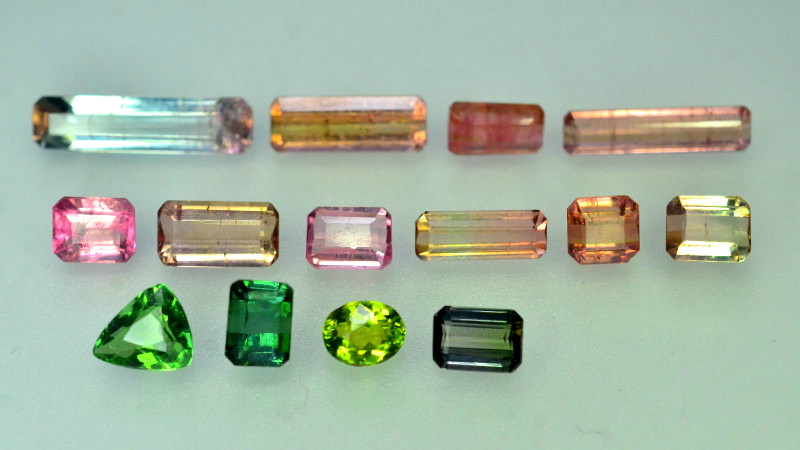 En la imagen de arriba: Varios colores y variedades de turmalinas facetadas.
En la imagen de arriba: Varios colores y variedades de turmalinas facetadas.
Las múltiples caras de la turmalina
La turmalina es un grupo complejo y variado de más de 30 minerales. Las especies más comunes son:
Schorl : Especie más común, alrededor del 95 por ciento de todas las turmalinas naturales; de color marrón a negro.
Dravita : Relativamente común; apodada “turmalina marrón”, pero puede tener otros colores.
Elbaíta : La especie de calidad gema más común, la más conocida y la más valiosa; puede ser prácticamente de cualquier color o multicolor.
Cada especie puede producir variedades con diferentes colores. Las variedades de turmalina más vendidas son:
Turmalina negra : Única variedad de chorlo; Turmalina más común; Siempre opaca
Turmalina cromada : dravita; rara, de color verde intenso
Indicolita : Elbaíta; Predominantemente azul
Turmalina Paraíba : Elbaíta; De color azul neón intensamente saturado a azul verdoso o violeta.
Rubelita : Generalmente elbaíta; variedad de color rosa saturado a rojo rubí, con posibles matices púrpura, marrón o naranja.
Verdelita : Elbaíta; Variedad verde a menudo llamada “esmeralda brasileña” o “ peridoto ceilandés”.
Turmalina Sandía : Elbaíta; Bicolor rosa y verde, generalmente con un centro rosa y un borde verde, a veces separados por una capa incolora
Siberita : Elbaíta, a veces considerada subtipo rubelita; apodada “turmalina púrpura”, aunque suele ser violeta rojiza o violeta rojiza.
La turmalina rosa, piedra de nacimiento, es una variedad de elbaíta, que suele pertenecer a la rubelita o la siberita. Entre las opciones multicolor se incluyen la turmalina sandía rosa y verde y la turmalina atardecer rosa y naranja.
La variedad más rara de turmalina es la turmalina Paraíba. Las turmalinas puras de color amarillo, naranja, azul, morado o con cambios de color también son raras.
Otro factor es el pleocroísmo , por el cual la turmalina es apreciada. Los ejemplares que presentan un pleocroísmo intenso son de mayor valor.
Hablando de valor, ¿cómo se clasifican las piedras natales de octubre?
 En la imagen de arriba: Turmalina sandía facetada
En la imagen de arriba: Turmalina sandía facetada
Evaluación de la calidad: características del ópalo y la turmalina
La clasificación de la turmalina es mucho más sencilla que la del ópalo. A continuación, nos centraremos en los factores estándar de valor de las gemas (color, talla, claridad, peso en quilates y tratamientos) tanto para el ópalo como para la turmalina. Puede obtener más información sobre cómo se clasifica el valor del ópalo aquí .
Color
Ópalo : Los principales factores de valor de estas piedras de nacimiento son su color (tono de cuerpo) y la presencia de juego de colores. El color más común del ópalo por tono de cuerpo es el blanco, seguido del gris y el verde. Los más raros son el negro o el rojo. En general, los ópalos preciosos son mucho más valiosos que los ópalos comunes.
El mejor juego de colores presenta destellos rojos (o de todos los colores), presenta patrones únicos y cubre toda la superficie de la piedra. Los ejemplares más oscuros, como los preciosos ópalos negros, presentan un juego de colores más brillante, lo que aumenta su valor.
Turmalina : El color más raro y valioso de la turmalina de octubre es la turmalina Paraíba. Las turmalinas negras, rojas y rosas son más comunes. El pleocroísmo verde y azul brillante, la particoloración o las propiedades de cambio de color pueden aumentar el valor de la piedra de nacimiento.
Cortar
Ópalo : Los ópalos no se facetan con tanta frecuencia como otras gemas; la variedad más común es el ópalo de fuego. Con mayor frecuencia, se ven ópalos tallados en cabujones o cuentas. El juego de colores se aprecia mejor en cabujones de ópalo translúcidos u opacos o en ópalos facetados totalmente transparentes. Muchos cabujones de ópalo son compuestos, como los dobletes o tripletes de ópalo.
Turmalina : Las gemas de turmalina suelen estar facetadas, a menudo con formas rectangulares alargadas. Se pueden optar por tallas brillantes para variedades más valiosas, como la turmalina Paraíba. Las turmalinas con abundantes inclusiones suelen elaborarse en cabujones o tallas, mientras que las piedras bicolores pueden tallarse.
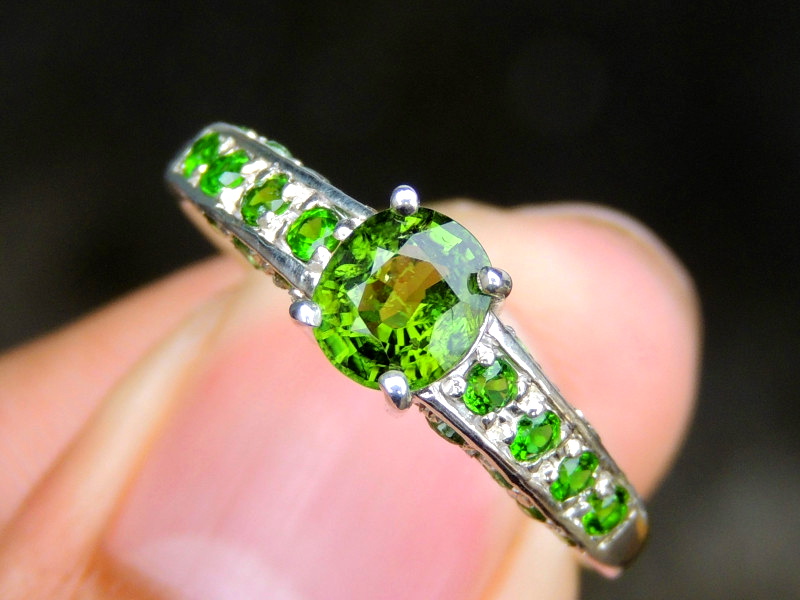 En la imagen de arriba: Anillo de turmalina cromada facetada.
En la imagen de arriba: Anillo de turmalina cromada facetada.
Claridad y transparencia
La claridad describe el grado de inclusiones visibles en una piedra, lo que reduce su transparencia y valor.
Ópalo : Las inclusiones generalmente reducen el valor del ópalo. Algunas inclusiones y material adicional alrededor del ópalo dan lugar a variedades distintas, como el ópalo dendrítico , el ópalo matriz y el ópalo boulder .
La transparencia total es poco común y valiosa en los ópalos, aunque los ópalos negros son más opacos. La turbidez suele reducir su valor.
Turmalina : La mayoría de las turmalinas tienen una claridad de Tipo II , lo que significa que se esperan pequeñas inclusiones visibles. Las turmalinas cromo y verde son de Tipo I (generalmente sin inclusiones), mientras que la turmalina Paraíba, la rubelita y la turmalina sandía son de Tipo III (siempre con inclusiones visibles).
Las inclusiones más visibles y la menor transparencia implican una turmalina de menor valor. La única inclusión que aumenta su valor es la presencia de tubos alineados que causan chatoyancia (efecto "ojo de gato").
La turmalina en sí es una inclusión del cuarzo turmalizado .
Peso en quilates
Ópalo : los ópalos más raros, como el ópalo negro o el ópalo cristal, pueden tener saltos de precio por quilate en intervalos como 1-5 cts, 5-10 cts y 10+ cts.
Turmalina : Las turmalinas, piedras de nacimiento, varían en tamaño, pero las gemas de más de 5 quilates son más caras. La variedad también importa: la turmalina cromo se encuentra comúnmente hasta 5 quilates, pero la turmalina Paraíba rara vez supera 1 quilate.
Tratos
Ópalo : Los ópalos sin tratar son significativamente más valiosos que los tratados, especialmente las variedades raras como el ópalo negro. Puedes aprender a analizar los tratamientos de ópalo aquí o llevar tu piedra de nacimiento de octubre a un laboratorio para confirmarlo.
Turmalina : Los tratamientos también reducen el valor de la turmalina, pero son comunes en esta piedra natal de octubre. Los tratamientos comunes (a menudo para mejorar el color o la claridad) incluyen la irradiación , el calor y/o el relleno de fracturas.
 En la imagen de arriba: colgante de ópalo negro australiano
En la imagen de arriba: colgante de ópalo negro australiano
Significados y creencias culturales de las piedras natales de octubre
¿Cuál es el significado espiritual de las piedras natales de octubre? Además de su asociación con el arcoíris, cada una posee su propio simbolismo y propiedades místicas.
Significado del ópalo
Según interpretaciones antiguas, los ópalos simbolizan pureza, esperanza y perspectiva. Los romanos los llamaban cupido paederos , o «niño tan hermoso como el amor».
A pesar de que los ópalos se tiñeron temporalmente en el siglo XIX debido a la superstición de que estaban malditos , muchas sociedades antiguas, como la china, creían que traían buena suerte. Una superstición común que persiste es que llevar ópalo trae mala suerte a quienes no nacieron en octubre.
Como piedra curativa , muchas de las supuestas propiedades del ópalo se centran en la visión y la mente. Se cree que los poderes curativos de la piedra natal de octubre incluyen el tratamiento de problemas de visión, el fortalecimiento de las capacidades cognitivas y la capacidad de ver el futuro.
Significados de la turmalina
En general, la turmalina, piedra natal de octubre, simboliza la compasión, la apertura mental y el perdón. A veces se la llama la "Piedra de la Reconciliación".
Cada color de turmalina tiene su propio significado y poderes curativos. Centrada en la turmalina rosa, se dice que esta gema de octubre aumenta la energía, fomenta el amor y ayuda a resolver problemas en las relaciones.
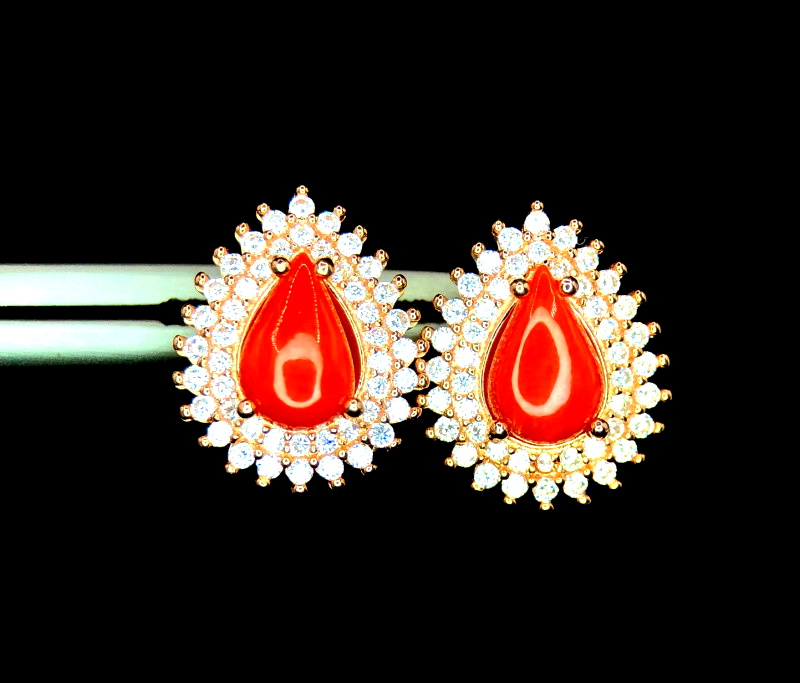 En la imagen de arriba: Pendientes de coral rojo.
En la imagen de arriba: Pendientes de coral rojo.
Piedras natales alternativas de octubre
¿Cuál es la piedra de nacimiento más popular para octubre? El ópalo suele ser la opción clásica, más popular que la turmalina, ¡pero existen otras piedras y cristales de nacimiento para octubre!
Las alternativas populares a las piedras de nacimiento de octubre son el berilo y el coral .
Astrológicamente, ¿cuál es la piedra de nacimiento de Libra ? Los nacidos en septiembre (después del 23) pueden beneficiarse del peridoto, el cuarzo rosa y la morganita .
¿Qué hay de las piedras de nacimiento de Escorpio ? Los nacidos en septiembre (antes del 23) pueden aprovechar la turmalina negra, la malaquita y el coral.
Regalos personalizados con la piedra natal de octubre
Ya tienes la gema, ¿y ahora qué haces con ella? Un gran regalo con la piedra de nacimiento de octubre nace del corazón y celebra a tu ser querido nacido en octubre.
Dado que octubre es uno de los meses de bodas más comunes, ¡un anillo con piedra de nacimiento de octubre también es una excelente manera de celebrarlo!
Incluso podrías conseguir joyas personalizadas, como un collar con la piedra de nacimiento de octubre y un diseño de caléndula, la flor del mes.
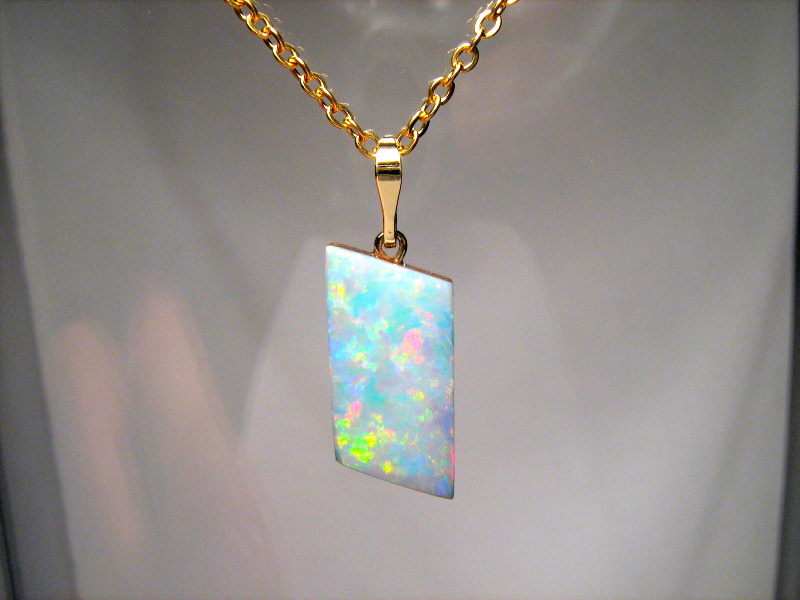 En la imagen de arriba: collar colgante de ópalo precioso blanco
En la imagen de arriba: collar colgante de ópalo precioso blanco
¿Estás muy contento con las piedras natales de octubre?
Tanto la turmalina como el ópalo son apreciados por su gama de colores y apariencia única. ¿Prefieres la turmalina rosa, recientemente formalizada, el ópalo tradicional, más antiguo, u otra piedra natal de octubre? ¡Sigue tu corazón para descubrir qué gema te define!
Encuentre piedras de nacimiento de octubre tradicionales y alternativas entre nuestros cientos de piedras preciosas disponibles , o explore nuestra extensa selección de ópalos en Opal Auctions .
Buscar en el Gemstone Encyclopedia
Subastas relacionadas
Artículos relacionados
Cada persona tiene una piedra preciosa que corresponde a su signo zodiacal. Estas también se conocen como tu Piedra Estelar. Aprende más sobre estas piedras y descubre cuál es tu Piedra Estelar.
10th May 2018
Originalmente, las piedras de nacimiento o gemas se asociaban con un signo zodiacal o el mes de nacimiento de una persona. Descubra cuál es su piedra y vea las que tenemos a la venta.
8th Feb 2021
Gem Rock Auctions ofrece una de las mayores colecciones de piedras preciosas certificadas en línea. Explore esta lista de laboratorios de análisis de piedras preciosas aprobados.
24th Jul 2018
últimos artículos
Chrysanthemum flower stones are natural wonders featuring a white calcite, celestite, or andalusite floral pattern set against black limestone or mudstone.
13th Jan 2026
La piedra solar reticulada arcoíris es una variedad de feldespato con tres magníficos efectos ópticos causados por la presencia de diversas inclusiones. Su vibrante colorido y su patrón reticular la convierten en una rara joya de colección.
12th Jan 2026
La thulita es una piedra preciosa noruega rara que exhibe un tono rosado vibrante de la familia de minerales zoisita que se usa comúnmente en engastes de joyería y colgantes.
6th Jan 2026
Categorías de artículos
How To's is where you will find helpful articles from gem Rock Auctions on how to cut gemstones, select gemstones and buy gemstones.
9 Artículos

![VS PINK AMETHYST [ROSE DE FRANCE] 2.7 CTS [S3315 ]](https://liveplatforms-production.b-cdn.net/tenants/gr/uploads/images/65000-69999/67441/67441_1230106381.jpg?width=480&aspect_ratio=1001%3A1000)
![VS PINK AMETHYST [ROSE DE FRANCE] 3.1 CTS [S3306 ]](https://liveplatforms-production.b-cdn.net/tenants/gr/uploads/images/65000-69999/67432/67432_1230105710.jpg?width=480&aspect_ratio=1001%3A1000)
![VS PINK AMETHYST [ROSE DE FRANCE] 3 CTS [S3284 ]](https://liveplatforms-production.b-cdn.net/tenants/gr/uploads/images/65000-69999/67410/67410_1230103437.jpg?width=480&aspect_ratio=1001%3A1000)
![VS PINK AMETHYST [ROSE DE FRANCE] 4.7 CTS [S3278 ]](https://liveplatforms-production.b-cdn.net/tenants/gr/uploads/images/65000-69999/67404/67404_1230102775.jpg?width=480&aspect_ratio=1001%3A1000)